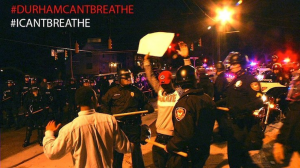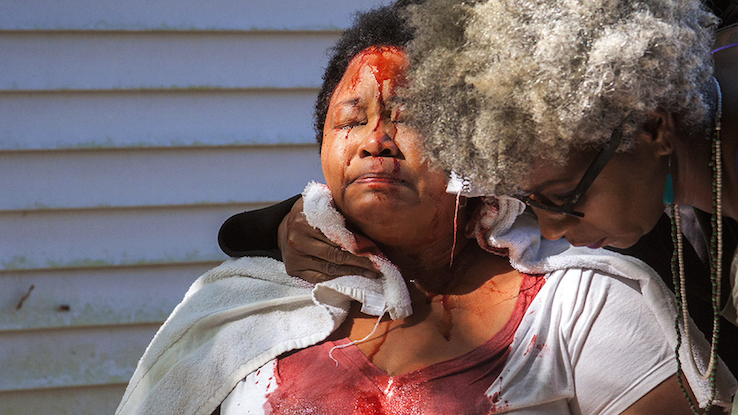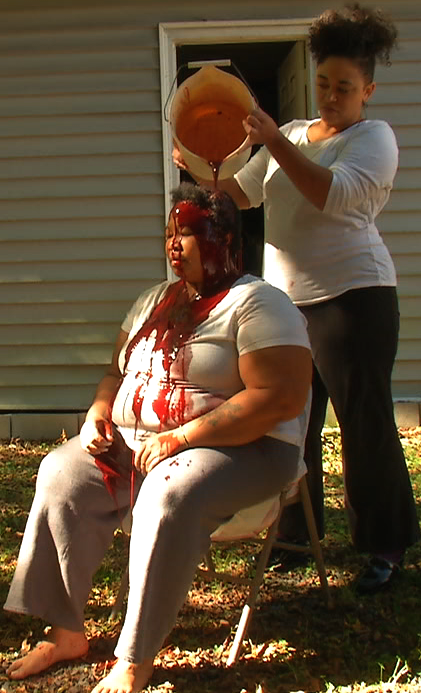Article by Nia Wilson (Durham, NC) and Rodrigo Dorfman (Durham, NC); Photographs by Rodrigo Dorfman
Reflections: Building towards “Mother to Mother”
Nia: August 10th 2014: I heard about the premature deaths of two young Black men — John Crawford in Ohio and Michael Brown in Missouri — while driving home from the food for your soul, ROOTS Week retreat. This annual retreat is special to me because I believe that it provides a space for alchemists, artists, and dreamers to practice the possibility of another world. I am usually hope-filled for at least a week afterward, before battle lines resurface and the slow drain begins. But this ride down the mountain would be different than previous years. This switch was abrupt and there was no way to avoid feeling sickened by how quickly the radio had forced reality back in. Who, besides a Black mama, will ever love a Black child completely?
Two more Black men, unarmed and killed by the police. Two more names to add to an already full list, occupied by Sean Bell, Oscar Grant, Jonathan Ferrell and [insert name here], [insert name here], [insert name here]… Two more Black lives to publicly dissect. Two Black mother’s mournings to scrutinize between traffic and weather updates. And my people are wailing in the street, as we have done so many times before.
A familiar knot, in my womb, swelled. She is ever present. Passed from my great, to my grand, to my mother. I too am a Black mother.
Rodrigo: The news at first always seems to come from far away. As a child of exile, distance was always present in my experience of the pain and the sorrow of mothers mourning their children. Chile was far from the places I lived: Paris, Amsterdam, and now Durham. And yet, I could feel it, because part of me was still back in Chile, struggling to stay connected, even if it meant that one more death on that far away soil bonded me closer to the country I had lost. Exile sometimes has a way of making the obvious and the mundane transcendental. I had never heard of Ferguson. The news came quickly, the anger and rage jumping through the television screen grabbing you, yes, that’s the word: grabbing you by the throat, by the hands, by the torso by every inch of your conscience demanding — not asking, mind you — demanding that you get up off your ass and move. Michael Brown’s body reminded me of so many photographs of bodies I had seen come out of Chile, bodies left in public view for everyone to see, everyone to be reminded that terror is random and you better know your place or else… Ferguson and my memories of Chile are bound by the logic of an international police state of mind I carry inside. I’m a Latino Jew — I pass for white. I am privileged and yet, every time I see a police officer my heart skips a beat, I tense up. Ferguson opened up all wounds. That’s what it feels like. An open wound.
Nia: October 19th 2014: The Black Lives Matter Movement was growing rapidly, and a group of us in Durham were moved to answer the call for a national day of solidarity against police brutality on October 22nd. We’d spoken so often, over the years, about the contradictions of black motherhood. The love, fear, beauty, and pain. Why we keep our cell phones fully charged at all times. And what happens in that moment when we have nothing left but our breath.
We had seen a YouTube video called “In Defense of Black Bodies — Blood Bucket Challenge,” which was “dedicated to confronting and overturning American systems of oppression that demean and disregard Black lives.” In the video a group of young Black people poured red liquid over their heads, as Nina Simone’s “Strange Fruit” played in the background.
We were inspired by their courage, fight, and pain. And we wanted to continue lifting this moment of Black power and pain. We let the producer of the YouTube clip know that we wanted to do a similar piece from Black mothers, and received their blessing.
Rodrigo: Witnessing. This is what I think about the most when I can stop, put my camera down and breathe. The act of Witnessing. This is where the jewel, the pearl of the documentary filmmaker hides. So many questions: what does it mean to witness the pain and joy of others? What is our responsibility when we see, when we look, when we witness? And what do we do with all those emotions that begin to burn and churn inside? And then there’s the eternal tension of the artist between being present and having the necessary critical distance to navigate real time aesthetics. For the past year or so, after running around the world filming my documentary on cultural resistance, Occupy the Imagination, I made the intentional choice to focus my craft on what I believe are the pressing social issues affecting Durham, the city I’ve lived in for most of my life. As I moved through documenting the creation of the Durham Civil Rights History Mural and initiated my relationship with SpiritHouse, I began to “see” differently. The Black Lives Matter movement is like a two by four. There is no academic subtlety here. Joining it forces you to check yourself in radical ways: listen, listen some more, and learn to step aside while understanding that you are here to serve the tending of an open wound. It is a humbling experience and an emotional roller coaster. The trust I have been given is the real privilege, and with the trust comes a deepening sense of witnessing and a refinement of my documentary skills. But most of all, sitting in the Love Shack,* listening to black mothers speak their minds and their fears and their dreams, sitting there, holding the focus tight, nice and steady and then being asked my opinion. And putting my camera down and becoming even more of an accomplice. What can I say, I never felt closer to home. And that’s as real as it gets.
Nia: And so we came together — Omisade Burney-Scott, Serena Sebring, Tia Hall, Nia Wilson (Rachael Derello joined us post conversation) — on couches, with cookies and tea at the beloved Love Shack in Durham, NC. Rodrigo Dorfman who’d been documenting our local movement, came to witness and document our creative process.
Mother to Mother: A Collective Brainstorm
What follows is transcribed from the conversation among Omisade Burney-Scott, Serena Sebring, Tia Hall, Nia Wilson as they developed “Mother to Mother: Collective Sun.”
Nia: Is that [the Blood Bucket Challenge] the way that I want to communicate to other Black moms? Does that speak to our fears? Or does it become a moment that’s more about the other audience, the audience that’s not Black mothers?
Omisade: How we could do something that’s communicating our solidarity? How are we communicating something that’s for them, but it’s also for me? I feel like in the midst of us communicating what we want, what’s in our hearts, what we’re praying for, and also to show something, like, fairly horrific. Because it is horrific.
Tia: The past weeks have been really triggery for me. We’re bombarded with images all the time. Its like our hurt is on display and other people get to have these moments of watching it.
Its important for me, as a mom, to let other moms know that we’re holding them.
Its a very stark hard image to see, and do we want to let that just sit in our minds? We’ve had different conversations over the months about the different shootings that have happened and how, going back into Jim Crow and lynching, how the bodies were left to sort of traumatize and inflict terror. So it sort of calls in my mind that we’re doing the same thing. I mean we’re not doing the same thing but that image is what’s left. I don’t wanna just leave you with how horrific. I wanna motivate you to some next steps but you’re not doing the next steps alone.
Serena: I don’t know where I’m at. I think I definitely have a churning, something going on in my heart about it. I think its a good question about the audience, because, I think, when you said the audience is other Black mothers, I thought, that’s not an audience I had thought of. When I was watching it, asking other people to watch it, encouraging other people to watch it, I’m like, “White people watch this.” Which doesn’t mean that we’re not always speaking to each other — we’re always speaking to other Black mothers.
I think I was thinking about Firewater,** which I think does get at the kind of hope in the midst of the trauma. What I was hearing in my mind for music, was a lullaby. And so to me the blood was not literal but like a spoiling, you know.
Which is what I feel about the hopefulness of Black mothers. Like that in some ways we have to sing our children to sleep. We send them out into the world and we know, all of the time because of the racist and the militaristic context, that they walk out into the world. That is also part of the sweetness and part of the hopefulness of being a Black mother at all times.
I really do want something that can communicate that… hold that contradiction which requires a little bit of shock value to me.
Nia: I was thinking that afterwards we have towels, and we wrap, and we cleanse after the pouring, so that its not just left. We are together in this.
I was thinking of all the mothers whose bodies have absorbed this pain. This is how we feel, and this is what we want to communicate to our children, and yet this is what we experience.
Serena: Or we know we could experience.
Omisade: The spoil, that is really powerful.
Serena: I agree and I think its different coming from those young people that made that video. It’s so direct for them. Even in their eyes, so intensely, this is what they fear they will experience and I don’t actually fear, when I walk out into the street, being shot by the police myself. I watch my rear view mirror, like anxiously, all the time, but its different than the ways that our young people face these threats, and I wanna make that visible too, while owning also the diversity of motherhood.
I think for me as a queer woman of color, as a queer Black mother that there is a way in which the array of young people that they had in that video was very powerful. The diversity of gender presentation was some of the most nuanced way of presenting the dynamics of racism, within the PIC [Prison Industrial Complex] — that is undeterred, or maybe even worsened by the different ways that we present gender-wise.
I think I would be in favor of at least two people doing it — because I think if we did one, whoever is that one becomes the representation of Black motherhood in a way that I don’t think is what we mean.
Nia: Well I’m also prepared, I have my sweats in my bag.
Omisade: If Serena had poured something on herself and I have a towel, I get to come behind her with the towel and I get to hold on to her for just a second and then I get to clean her off right. That feels really powerful.
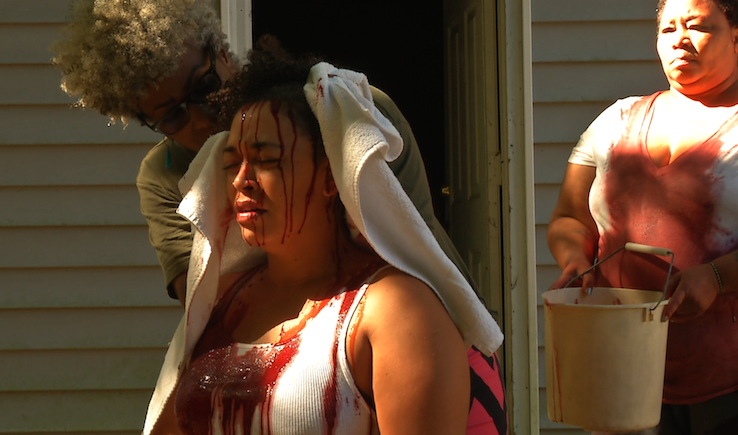 Serena: What I want to do, when you do that, is just like be held.
Serena: What I want to do, when you do that, is just like be held.
And, I wanna hold the importance of both being strong and being sort of unflinching.
I think I don’t know how to hold both of those things. And I think they’re so important.
And maybe its not important that we’re just stoic.
Maybe that’s not true, I don’t know.
Tia: I really want to get rid of the mythology of the strong Black woman — like nobody sees our pain really, and if we’re stoic its like, yeah, they can move on through it.
And there are parts of me, like, I am fragile too.
I have those broken places and those places where I need nurturing and being held.
But the narrative, you know, is that we don’t feel.
Serena: I think there’s also another narrative too though. I think there’s a lot of Black mothers crying on the news right now — even going back to, like, Emmit Till’s mother. Like her display of affect. Her display of that is like an icon. And so now we see: young black man killed, mother crying.
What we miss is the sweetness.
What you miss is the hopefulness.
Nia: I can pour. I don’t necessarily want to pour.
I want to bear and I want to be held.
And I want people to know that we bear, and that we hold.
Serena: I agree and I think even the pause between — I think there are two kinds of active witnessing going on. Like, there’s the watching the blood and then it doesn’t have to be an immediate [reaction] because then its a thoughtful hold.
Then it’s — I’ve seen this pain and I’m gonna think about what to do and I’m gonna act.
Which is the message for the white people I want to send it to.
And its also the message for the Black mothers that I want to send it to — that we can hold each other. That we are survivors and that we are surviving as a community.
That that’s not the end of this story.
Omisade: The beat, like there not being an immediate kind of swooping in — there being a beat and then … its a very calm kind of like, I’m here. I’m here.
And then starting to cleanse off, and then helping her stand up.
Standing beside each other holding hands.
You know, like when Michael Brown’s mother was meeting with Sabrina Fulton and Sean Bell’s mother, she was gone… I was like she doesn’t feel anything right now. She is gone.
And I know that Sabrina and Sean Bell’s mom looking at her knew where she was. And they were like, you know what? We’re gonna speak right here cause this baby right here is gone.
I imagine with the blood being poured whatever emotion that will come out of the both of you guys will be so real in that moment and that what Tia and I get to do is that: be like okay, we got you.
We gonna cleanse you off, we gonna stand up, we gonna hold your hands, we gonna be right here with you. We’re just gonna hold that. We’re just gonna hold that.
This blood is really powerful because I think one of the things that really stuck with me around Michael Brown is that they left him in the street for such a long time.
And that his mother was like this is where my baby was.
In the street
That stained
That stained
* The Love Shack is the home of Serena Sebring, Emily Chavez and their family. It is also a creative space that they have opened to Durham community members working together for our liberation.
**Firewater is the final poem in the SpiritHouse production of “Collective Sun–Reshape the Mo(u)rning.” It is also the poem that is shared in the Mother to Mother Collective Sun video.
_______
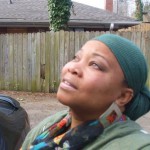 Nancy “Mama Nia” Wilson has been a part of the SpiritHouse family since 2002. Currently serving as the SpiritHouse Executive Director, Mama Nia originally hails from Norwalk, CT, where she has acquired over twenty years of direct care client services, ranging from early childhood education to mentally handicapped adults. She is a practical nurse who has specialized in pediatric and psychiatric nursing, but found a much stronger calling working with teens and their families in drop-out, drug and pregnancy prevention. Mama Nia is a mother, poet, performer, and storyteller, whose works with fellow artists, organizers, encourages community members to assess, express, and address their own needs.
Nancy “Mama Nia” Wilson has been a part of the SpiritHouse family since 2002. Currently serving as the SpiritHouse Executive Director, Mama Nia originally hails from Norwalk, CT, where she has acquired over twenty years of direct care client services, ranging from early childhood education to mentally handicapped adults. She is a practical nurse who has specialized in pediatric and psychiatric nursing, but found a much stronger calling working with teens and their families in drop-out, drug and pregnancy prevention. Mama Nia is a mother, poet, performer, and storyteller, whose works with fellow artists, organizers, encourages community members to assess, express, and address their own needs.
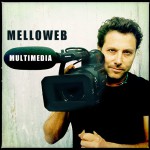 Rodrigo Dorfman is an award winning filmmaker and multimedia producer who has worked with POV, HBO, Salma Hayek’s Ventanazul and the BBC among others. His films have been screened at some of the top international film festivals in the world (Toronto, Full Frame, Edinburgh, Telluride, Human Rights Watch). He is currently working on NUEVOlution! Latinos and the New South, a national touring exhibit of the Levine Museum of the New South based on his documentary work.
Rodrigo Dorfman is an award winning filmmaker and multimedia producer who has worked with POV, HBO, Salma Hayek’s Ventanazul and the BBC among others. His films have been screened at some of the top international film festivals in the world (Toronto, Full Frame, Edinburgh, Telluride, Human Rights Watch). He is currently working on NUEVOlution! Latinos and the New South, a national touring exhibit of the Levine Museum of the New South based on his documentary work.


